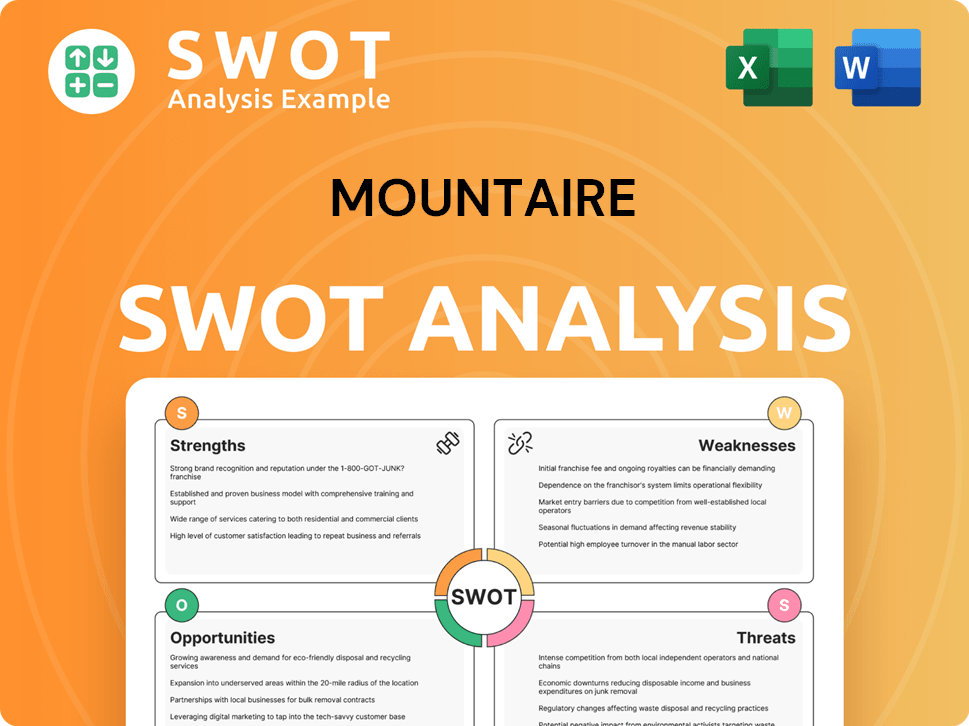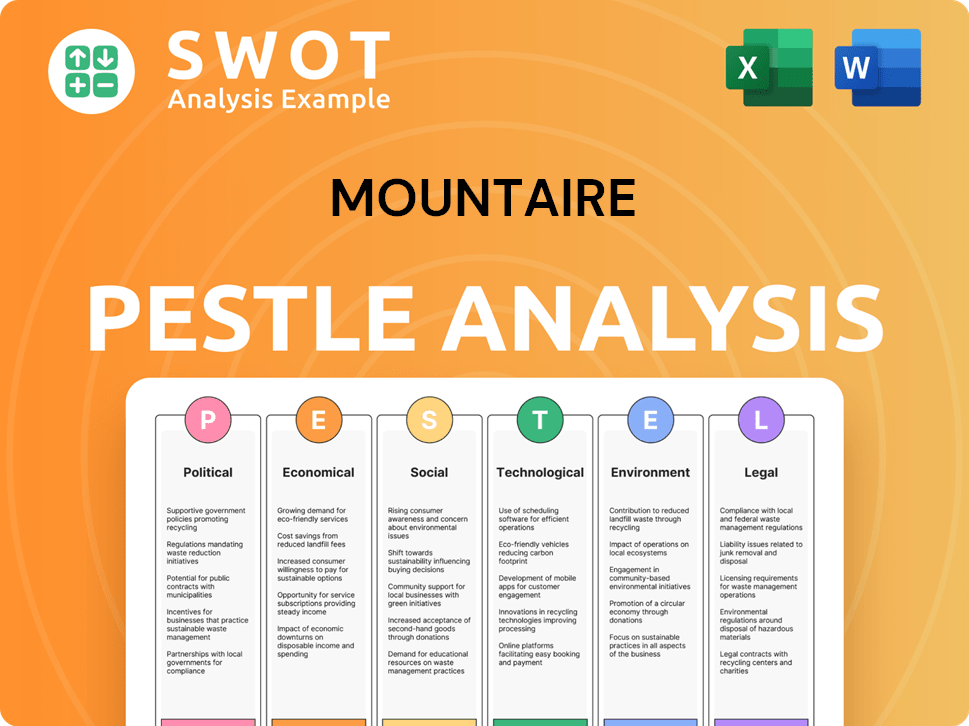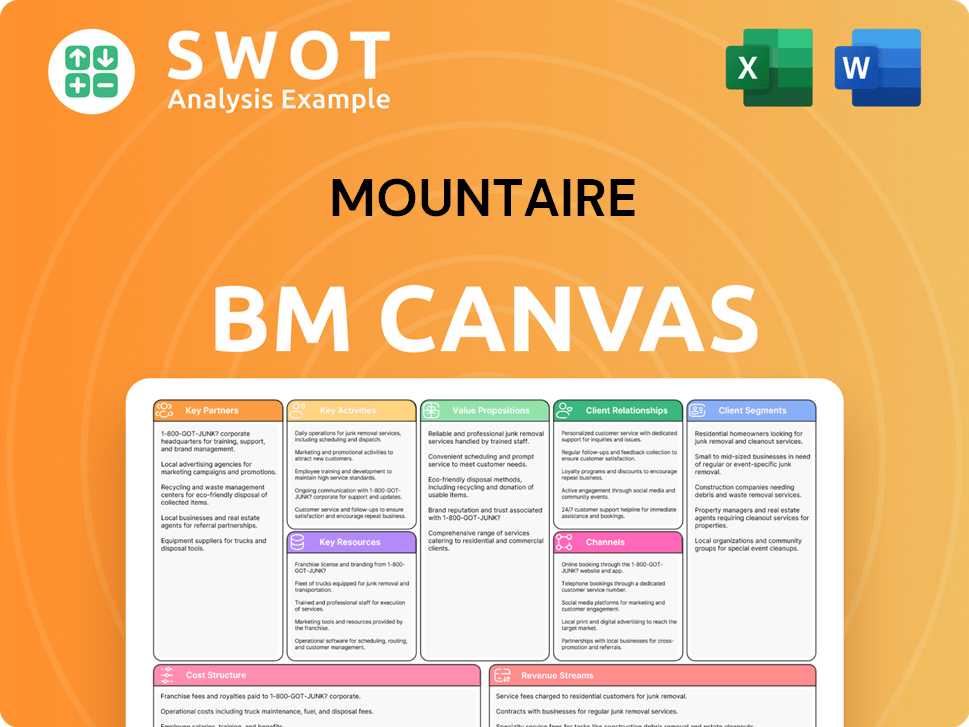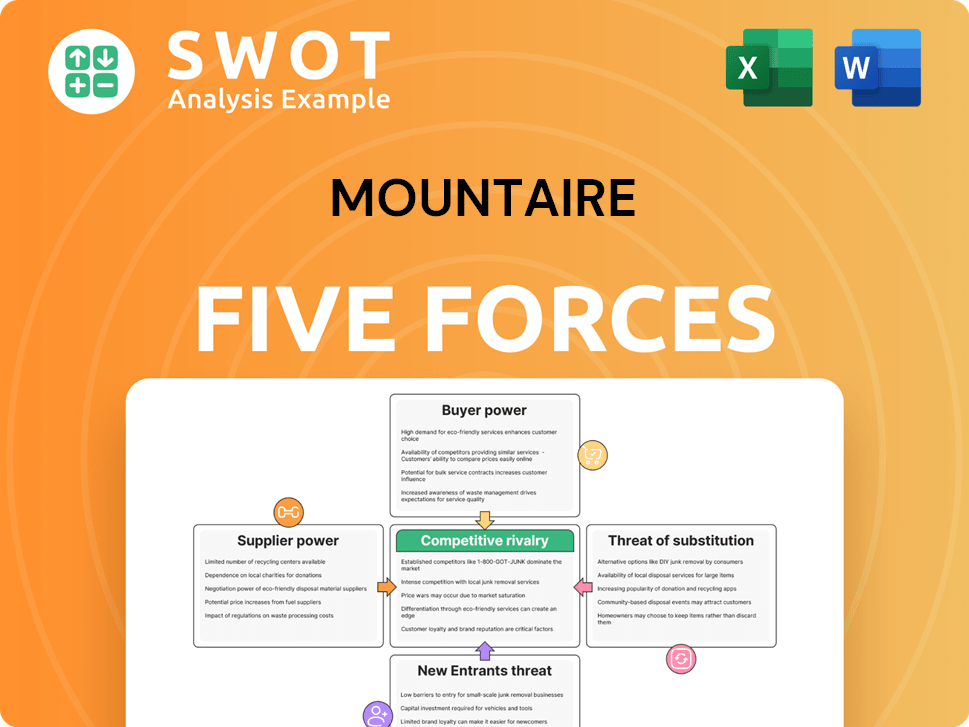Mountaire Bundle
How Does Mountaire Navigate the Poultry Industry's Competitive Arena?
The poultry industry is a dynamic sector, constantly reshaped by consumer demands and technological advancements. Mountaire Corporation, a significant player since 1914, has consistently adapted to these changes. Understanding Mountaire's position requires a deep dive into its competitive landscape.

This analysis will explore Mountaire's Mountaire SWOT Analysis, market position, and key rivals within the poultry industry competition. We'll examine its competitive advantages and how it stacks up against chicken processing companies, providing a comprehensive Mountaire market analysis. This will help you understand who are Mountaire Farms' main competitors and its strategies for success.
Where Does Mountaire’ Stand in the Current Market?
Mountaire Corporation holds a significant position within the U.S. poultry industry. As of 2024-2025, it ranks as the eighth-largest chicken company in the nation. Its consistent presence among the top producers highlights its substantial operational scale and market influence. The company's primary focus is on high-quality poultry products, catering to a diverse customer base including retail, foodservice, and institutional clients.
The company's operations are primarily concentrated in the Mid-Atlantic and Southern United States. Its facilities, which include feed mills, hatcheries, and processing plants, are spread across Delaware, Maryland, North Carolina, and Arkansas. This geographic concentration allows for efficient operations and strong relationships with local agricultural networks. Mountaire’s commitment to vertical integration, from grain sourcing to product distribution, plays a crucial role in its ability to maintain control over its supply chain and deliver products efficiently.
Mountaire's market position is also shaped by its strategic focus on high-quality poultry, which suggests a positioning that balances cost-effectiveness with product integrity. The company's financial health, though not publicly detailed due to its private ownership, is reflected in its sustained growth and investments in infrastructure, including recent expansions and upgrades to its facilities. This indicates a robust financial standing compared to industry averages for similarly sized private enterprises.
Mountaire's core operations revolve around the production and distribution of high-quality poultry products. The company manages its supply chain through vertical integration, which includes feed mills, hatcheries, and processing plants. This approach ensures control over the entire production process, from sourcing raw materials to delivering finished products to customers.
The value proposition of Mountaire centers on providing high-quality poultry products to a diverse customer base. This includes retail, foodservice, and institutional clients. By focusing on quality and maintaining a vertically integrated supply chain, Mountaire aims to offer reliable and cost-effective products.
Mountaire's geographic presence is primarily concentrated in the Mid-Atlantic and Southern United States. Operations are spread across Delaware, Maryland, North Carolina, and Arkansas. This regional focus allows for efficient operations and strong relationships with local agricultural networks.
Mountaire has demonstrated a strategic focus on vertical integration to maintain control over its supply chain. This comprehensive approach contributes to its efficiency and ability to consistently deliver products. The company's emphasis on high-quality poultry suggests a positioning that balances cost-effectiveness with product integrity.
While specific market share data for 2024-2025 is not publicly available, Mountaire's consistent ranking as the eighth-largest chicken company indicates a significant market presence. The company's financial health, though not publicly detailed, is reflected in its sustained growth and investment in infrastructure. This suggests a robust financial standing compared to industry averages for similarly sized private enterprises. For more insights, consider reviewing the Target Market of Mountaire.
- Mountaire's strong regional presence leverages local agricultural networks.
- The company's vertical integration strategy enhances operational efficiency.
- Focus on high-quality poultry products supports its market positioning.
- Sustained investments indicate a healthy financial outlook.
Mountaire SWOT Analysis
- Complete SWOT Breakdown
- Fully Customizable
- Editable in Excel & Word
- Professional Formatting
- Investor-Ready Format

Who Are the Main Competitors Challenging Mountaire?
The Growth Strategy of Mountaire involves navigating a complex competitive landscape within the U.S. poultry market. Understanding the key players and their strategies is crucial for assessing Mountaire's position and potential for growth. This analysis requires a deep dive into the competitive dynamics, including market share, product offerings, and operational efficiencies.
The poultry industry is characterized by intense competition, with companies constantly vying for market share and consumer preference. Mountaire faces both direct and indirect competition, necessitating a strategic approach to maintain and improve its market position. This includes adapting to changing consumer demands, optimizing distribution channels, and innovating in product development.
Mountaire Corporation operates in a highly competitive environment. Its primary competitors include industry giants and other players who challenge it across various fronts.
The most significant direct competitors include Tyson Foods, Pilgrim's Pride, Perdue Farms, and Wayne-Sanderson Farms. These companies compete directly with Mountaire in the poultry market.
As the largest U.S. meat producer, Tyson Foods leverages extensive distribution networks and strong brand recognition. Tyson Foods challenges Mountaire through its sheer scale and market penetration. In fiscal year 2023, Tyson Foods reported revenues of approximately $52.9 billion.
Pilgrim's Pride, a subsidiary of JBS S.A., competes aggressively on price and efficiency. Pilgrim's Pride often benefits from its global parent company's resources. JBS S.A. reported revenues of $62.3 billion in 2023.
Perdue Farms focuses on animal welfare and organic/no-antibiotics-ever poultry. Perdue Farms competes with Mountaire on product differentiation and premium market segments. Perdue Farms' revenue was estimated at $9.5 billion in 2023.
The acquisition of Sanderson Farms by Cargill and Continental Grain in 2022 created Wayne-Sanderson Farms. Wayne-Sanderson Farms is the third-largest poultry producer in the U.S., intensifying competition. The combined entity has a significant market share.
Mountaire also faces indirect competition from other protein sources like beef, pork, and plant-based alternatives. These alternatives are disrupting traditional meat consumption patterns. The plant-based meat market is growing, with revenues expected to reach $7.7 billion in 2025.
Mountaire faces challenges in pricing strategies, product innovation, brand loyalty, and distribution. The poultry industry competition necessitates continuous adaptation to maintain market position.
- Pricing Strategies: Competitors continuously adjust prices to gain market share.
- Product Innovation: Developing value-added poultry products is crucial.
- Brand Loyalty: Building and maintaining brand loyalty is essential.
- Distribution Channel Optimization: Efficient distribution networks are critical.
- Consumer Preferences: Adapting to consumer demands for convenience and sustainability.
- Market Share: Companies that quickly adapt to changing consumer demands often gain market share.
- Operational Efficiency: Continuous drive for operational efficiency is essential.
Mountaire PESTLE Analysis
- Covers All 6 PESTLE Categories
- No Research Needed – Save Hours of Work
- Built by Experts, Trusted by Consultants
- Instant Download, Ready to Use
- 100% Editable, Fully Customizable

What Gives Mountaire a Competitive Edge Over Its Rivals?
Understanding the Owners & Shareholders of Mountaire is crucial for assessing its competitive landscape. The company's strategic positioning hinges on its operational model, regional focus, and commitment to quality. A deep dive into these aspects reveals the core strengths that define its market presence and ability to compete within the poultry industry.
The competitive advantages of Mountaire Corporation are primarily rooted in its vertically integrated operations, strong regional presence, and dedication to quality and efficiency. This integrated approach, encompassing feed mills, hatcheries, and processing plants, grants the company significant control over its production processes, enabling consistent quality and cost optimization. This integrated model allows for better control over the supply chain, reducing dependence on external suppliers and enhancing responsiveness to market demands.
Furthermore, Mountaire's established relationships with contract growers and its deep understanding of the agricultural landscape in its primary operating regions provide a competitive edge. This regional focus optimizes logistics, reduces transportation costs, and fosters stronger community ties, contributing to a stable workforce. Mountaire's emphasis on high-quality poultry products, achieved through continuous investment in processing technologies and food safety protocols, further solidifies its competitive advantage. These advantages are leveraged in marketing efforts, emphasizing freshness, quality, and locally sourced aspects to appeal to consumers.
Mountaire's vertical integration, from feed production to processing, ensures quality control and cost efficiency. This model allows for better management of the supply chain and quicker responses to market changes. This control is a significant barrier to entry for new competitors in the chicken processing companies sector.
Operating primarily in the Mid-Atlantic and Southern U.S. allows for optimized logistics and stronger community ties. This regional concentration facilitates efficient distribution and builds a dedicated workforce. The geographic market presence is a key factor in its operational success.
Continuous investment in processing technologies and food safety protocols ensures high-quality products. This commitment enhances consumer trust and brand reputation. Innovation in production processes is crucial for maintaining a competitive edge.
Mountaire's supply chain analysis reveals a robust system that minimizes risks and maximizes efficiency. The company's ability to manage its supply chain effectively is a critical competitive advantage. This is especially important in the volatile food industry.
Mountaire's competitive advantages stem from its integrated operations, regional focus, and commitment to quality. These factors enable the company to maintain a strong position within the poultry industry competition. The company's strategic moves are designed to enhance these strengths.
- Vertical Integration: Ensures control over the entire production process.
- Regional Focus: Optimizes logistics and strengthens community ties.
- Quality Products: Achieved through continuous investment in technology and safety.
- Supply Chain Efficiency: Reduces costs and enhances responsiveness.
Mountaire Business Model Canvas
- Complete 9-Block Business Model Canvas
- Effortlessly Communicate Your Business Strategy
- Investor-Ready BMC Format
- 100% Editable and Customizable
- Clear and Structured Layout

What Industry Trends Are Reshaping Mountaire’s Competitive Landscape?
The competitive landscape for poultry producers in the United States is dynamic, influenced by consumer preferences, technological advancements, and economic factors. The Marketing Strategy of Mountaire must adapt to the evolving demands of the market. This requires a deep understanding of industry trends, potential challenges, and emerging opportunities to maintain and enhance its market position.
The poultry industry faces continuous shifts driven by consumer demand for healthier and sustainably sourced products. This includes antibiotic-free, organic, and humanely raised poultry, requiring companies to invest in animal welfare and transparent supply chains. Economic volatility, particularly in feed ingredient prices, and regulatory changes also present challenges for companies like Mountaire. However, this also creates opportunities for innovation, expansion, and strategic partnerships.
The poultry industry is seeing a rise in demand for healthier and sustainably sourced products. Automation and AI are being adopted to improve efficiency and food safety. Regulatory changes related to environmental impact and labor practices are also impacting the industry.
Volatility in feed ingredient prices, especially corn and soybean, poses a significant threat. The rise of plant-based protein alternatives could disrupt traditional meat consumption patterns. Adapting to complex regulatory landscapes and increasing operational costs are ongoing challenges.
Growing demand for value-added poultry products offers avenues for higher profit margins. Expanding into international markets presents significant growth opportunities. Strategic partnerships with technology providers can enhance operational efficiency and distribution.
Innovation in sustainable practices and leveraging advanced technologies are key. Adapting the product portfolio to changing consumer preferences is crucial. A proactive approach to challenges and agility in capitalizing on market opportunities are essential for success.
The Mountaire competitive landscape includes major players such as Tyson Foods and Pilgrim's Pride, who are key Mountaire Farms competitors. The company's market position is influenced by its ability to innovate, leverage technology, and adapt to consumer preferences. Understanding the dynamics of poultry industry competition is crucial for strategic planning.
- Mountaire Farms market share analysis indicates a significant presence in the U.S. poultry market.
- Chicken processing companies are continuously investing in automation and sustainable practices.
- Mountaire Farms financial performance compared to competitors highlights the importance of cost management and operational efficiency.
- Mountaire Farms SWOT analysis reveals strengths, weaknesses, opportunities, and threats, guiding strategic decisions.
Mountaire Porter's Five Forces Analysis
- Covers All 5 Competitive Forces in Detail
- Structured for Consultants, Students, and Founders
- 100% Editable in Microsoft Word & Excel
- Instant Digital Download – Use Immediately
- Compatible with Mac & PC – Fully Unlocked

Related Blogs
- What are Mission Vision & Core Values of Mountaire Company?
- What is Growth Strategy and Future Prospects of Mountaire Company?
- How Does Mountaire Company Work?
- What is Sales and Marketing Strategy of Mountaire Company?
- What is Brief History of Mountaire Company?
- Who Owns Mountaire Company?
- What is Customer Demographics and Target Market of Mountaire Company?
Disclaimer
All information, articles, and product details provided on this website are for general informational and educational purposes only. We do not claim any ownership over, nor do we intend to infringe upon, any trademarks, copyrights, logos, brand names, or other intellectual property mentioned or depicted on this site. Such intellectual property remains the property of its respective owners, and any references here are made solely for identification or informational purposes, without implying any affiliation, endorsement, or partnership.
We make no representations or warranties, express or implied, regarding the accuracy, completeness, or suitability of any content or products presented. Nothing on this website should be construed as legal, tax, investment, financial, medical, or other professional advice. In addition, no part of this site—including articles or product references—constitutes a solicitation, recommendation, endorsement, advertisement, or offer to buy or sell any securities, franchises, or other financial instruments, particularly in jurisdictions where such activity would be unlawful.
All content is of a general nature and may not address the specific circumstances of any individual or entity. It is not a substitute for professional advice or services. Any actions you take based on the information provided here are strictly at your own risk. You accept full responsibility for any decisions or outcomes arising from your use of this website and agree to release us from any liability in connection with your use of, or reliance upon, the content or products found herein.